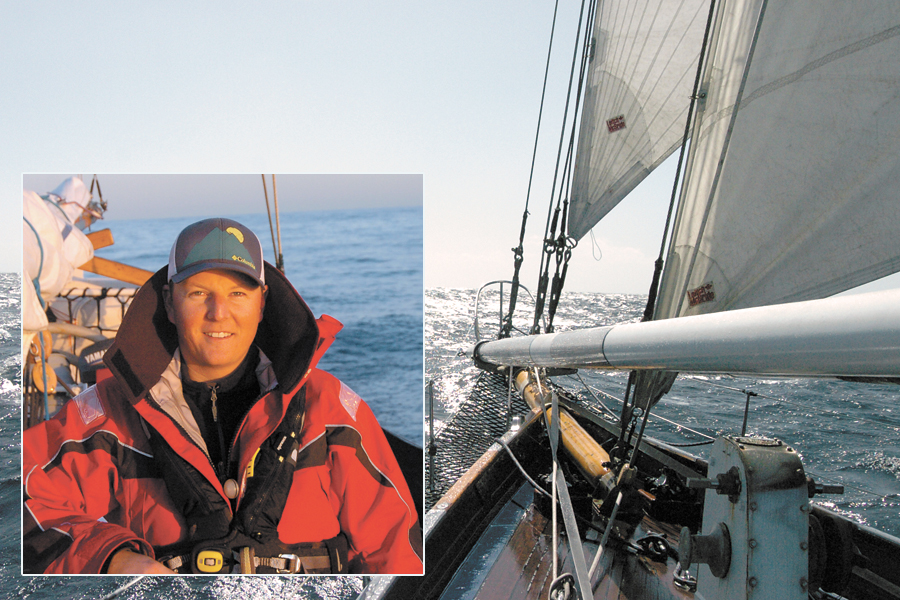Q&A: Life on board Oriole as it sails the globe
By Lookout on May 28, 2017 with Comments 0

Lieutenant (Navy) Tom Eagle
Peter Mallett, Staff Reporter ~
Lieutenant (Navy) Tom Eagle is one of 20 crew members posted to HMCS Oriole, the 31-metre ambassadorial sailing ketch heading to Charlottetown, P.E.I., for this summer’s Canada 150 celebrations.
He is Oriole’s Watch Captain, Navigating Officer and the Executive Officer.
With the stormy harrowing seas of the Pacific Northwest well behind them, the calm seas of the Oaxaca coastline provided Lt(N) Eagle an opportunity to respond to questions about the voyage.
Q: What were the conditions like during the first part of your voyage through the Pacific Northwest and how rough were the seas?
A: The Oregon coast was rather rough, but not record setting and certainly not the “perfect storm” as some may call it. We had high winds and large waves on our first attempt at rounding Cape Flattery [off Washington’s Olympic Peninsula], which ended in an anchorage in Port Renfrew overnight. For all involved – save myself, the commanding officer, buffer and a Leading Seaman with some civilian open ocean sailing experience – this was a first chance to see what life on a sailboat feels like offshore.
Q: What have been the biggest challenges and adjustments to life at sea?
A: Oriole doesn’t have a lot of the creature comforts the rest of the navy is accustomed to. Not getting a hot shower for a few days on Algonquin was par for the course, but not having onboard showers in Oriole is a little daunting because the deck starts to heat up and the ambient temperature listed on the thermometer above my rack is above 35c, [which starts the sweat rolling]. It’s just another thing you need to get used to rather quickly.
Q: What are your living quarters like? Closer confines than in a frigate or a submarine?
A: I live with the Captain in his cabin and since we have the luxury of our own heads, a couple of drawers and a bit of privacy, I can’t complain at all. The rest of the crew are living in cramped quarters. The V-Berth at the front of the ship has eight racks, no lockers and the only storage they get is a small cubby directly under their mattress. In sum, the quarters can’t be compared to any of those in the navy. The only thing you could compare it to would be a small sailboat.
Q: What do most of your daily tasks involve, and the rest of the crew?
A: I stand in 1-in-2 [duty] watches on the helm when the sails are up and generally as a watch captain or Officer of the Watch. I also monitor our progress and plan ahead for ports throughout the deployment. I also manage the ship’s Facebook and Twitter feeds. The crew itself has different tasks, but the majority of the crew rotate between lookout, helmsman and odd jobs that need to be done to maintain the sails rigging. Cleaning, we have a lot of brass on board and salt water does a real number on it, so we spend a lot of time polishing the brass.
Q: What has the food been like and is the crew well fed?
A: Our Leading Seaman cook joined the navy as a classically trained French Chef. Regular PT is a must lest we have trouble fitting through the tighter hatches! The ability to store fresh rations on board is limited, but he does a fantastic job. No complaints, we eat better than most frigates I am sure.
Q: How do you stay fit on the vessel?
A: Most of the tasks on board are a little more active than a typical job in the navy. Our heaviest sail weighs over 500 lbs when dry and needs to be carried to the bow and pulled to the top of the mast using only muscle power. We also have a couple of sets of dumbbells and a little deck space, so when there isn’t much sea state there is an opportunity to do a little lifting. Also we manage yoga and circuit training somewhat regularly.
Q: What do you like most about the experience so far?
A: The transit between Puerto Vallarta and Huatulco, Mexico, was very rewarding as we had near perfect conditions. It was hot, granted, but sleeping wasn’t too hard until the last couple of days, but otherwise we were making good and travelling at a speed of around seven knots under sail for each day and the leg flew by. Also because we had made such good time under sail, we were allowed to go for a swim and relax a little.
Q: What do you like least about the experience?
A: Rain in your eyes for seven hours on the mids is a pretty rough time.
Q: Have you seen any notable wildlife during the voyage?
A: Thousands of dolphins, flying fish, jellyfish, sunfish, and sea turtles. We also saw a bunch of Humpback whales outside of Eureka, Ca.
Q: What has been the biggest challenge facing the crew as a whole?
A: Lately it is the heat. We’re acclimatizing to it slowly and the boat stays very warm after the engine is running. If you asked a month ago, it would have been wet clothes and rain gear. You can’t dry salty soaked foul weather gear in a damp environment, it just won’t happen.
Q: What is the best way to follow and track the Oriole as it continues its journey?
A: Pat Bay Webcam is tracking us through the voyage at: http://patbaywebcam.com/oriole.php We are also on Facebook @HMCSNCSM ORIOLE or Twitter @HMCS_NCSM ORIOLE
Q: How much anticipation is there toward arriving in Charlottetown for Canada 150 celebrations?
A: That’s the whole purpose of the trip, and we’re going to cover nearly 20,000 nautical miles getting there. I’m expecting the celebration in Charlottetown to be quite something. We are just focused on getting there on time, in one piece, and ready to show a ton of Canadians another side of the CAF.
Q: Can you describe your overall feeling about being part of this deployment?
A: Like with all huge endeavours, you have to take it leg by leg. It didn’t really even sink in that we were actually doing this trip until we pulled out of San Diego. For the most part, Esquimalt to San Diego are familiar waters for the navy. It’s also a week-long trip for a frigate. Once you’re south of San Diego, you’re out of the norm. Once we started realizing we were farther south than that boat had been since 1999, and further east than she’d been since 1984, we realized we were actually doing something unique.
Filed Under: Top Stories
About the Author:





